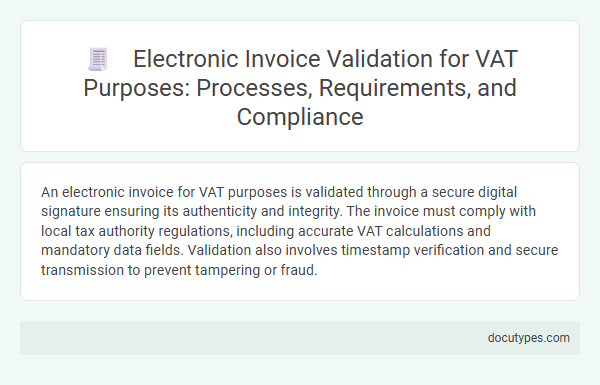An electronic invoice for VAT purposes is validated through a secure digital signature ensuring its authenticity and integrity. The invoice must comply with local tax authority regulations, including accurate VAT calculations and mandatory data fields. Validation also involves timestamp verification and secure transmission to prevent tampering or fraud.
Introduction to Electronic Invoice Validation for VAT
Electronic invoice validation is a critical process ensuring compliance with VAT regulations. It verifies the authenticity, integrity, and accuracy of digital invoices for tax purposes.
- Authentication - Confirms the identity of the invoice issuer using secure digital signatures.
- Data Integrity Check - Ensures the invoice content has not been altered after issuance.
- Compliance Verification - Validates that the invoice meets all VAT legal requirements and formats.
Key Legal Requirements for VAT-Compliant E-Invoices
How is an electronic invoice validated for VAT purposes? Validation requires adherence to strict legal criteria that ensure authenticity, integrity, and legibility throughout the invoice lifecycle. Key legal requirements include the use of advanced electronic signatures or qualified electronic seals, which confirm the origin and integrity of the invoice data.
What elements must be included in a VAT-compliant electronic invoice? Your e-invoice must clearly display mandatory information such as the supplier's VAT identification number, invoice date, unique invoice number, description of goods or services, quantity, and VAT rate applied. Ensuring accurate tax codes and total VAT amount is critical to meet regulatory standards and facilitate tax audits.
Why is invoice traceability important for VAT validation? Traceability enables tax authorities to verify the invoice's authenticity and the correctness of VAT declarations. Electronic invoices must be stored in a format that preserves their original content and format, making them easily accessible for inspection during the legally required retention period.
Core Processes in Electronic Invoice Validation
Electronic invoice validation for VAT purposes involves specific processes to ensure authenticity and compliance with tax regulations. These core processes guarantee the accuracy and legitimacy of the invoice data submitted for VAT reporting.
- Authentication of Origin - Confirms the identity of the invoice issuer to prevent fraud and ensure the invoice is issued by a registered taxpayer.
- Integrity Verification - Ensures that the invoice content has not been altered after issuance by using digital signatures or secure electronic seals.
- Data Accuracy Check - Validates essential VAT-related information such as VAT numbers, invoice amounts, tax rates, and compliance with local tax laws.
E-Invoice Formats Accepted for VAT Purposes
Electronic invoices must comply with specific formats to be validated for VAT purposes. Proper format ensures accurate data capture and legal acceptance across tax authorities.
- UBL (Universal Business Language) - Extensively used e-invoice format designed for interoperability and standardized VAT reporting.
- XML Format - Structured data format allowing detailed fiscal information exchange compliant with VAT regulations.
- PEPPOL BIS - A recognized e-invoicing standard within European countries for VAT-compliant invoice exchange.
Your e-invoice must strictly adhere to these accepted formats for VAT validation and tax deduction eligibility.
Mandatory Data Elements in VAT E-Invoices
An electronic invoice must include specific mandatory data elements to be validated for VAT purposes. These elements ensure compliance with tax regulations and facilitate accurate VAT reporting.
The key mandatory data elements in VAT e-invoices include the supplier's name and VAT identification number, the buyer's details, invoice date, and a unique invoice number. The description of goods or services, quantity, unit price, and total amount excluding VAT are essential. You must also include the applicable VAT rate and the total VAT amount charged.
Role of Digital Signatures and Authentication
| Aspect | Description |
|---|---|
| Electronic Invoice Validation | Verification to ensure compliance with VAT legislation and authenticity of transaction data. |
| Role of Digital Signatures | Digital signatures provide cryptographic proof of the origin and integrity of the invoice. They confirm that the invoice was issued by the legitimate supplier and has not been altered after signing. |
| Authentication Process | Involves the use of secure certificates issued by trusted Certificate Authorities (CAs) to authenticate the identity of the invoice issuer. |
| Legal Compliance | Digital signatures meet legal requirements for VAT purposes by ensuring non-repudiation and traceability of electronic invoices. |
| Data Integrity | Authentication mechanisms confirm that the invoice content remains unchanged from issuance to receipt. |
| Tax Authority Requirements | Many jurisdictions mandate digital signatures or equivalent electronic authentication to validate electronic invoices for VAT reporting and audit. |
| Technology Standards | Standards like XML signing (XAdES), Public Key Infrastructure (PKI), and Secure Hash Algorithms (SHA) support digital signature processes. |
Automated Compliance Checks and Audit Trails
Electronic invoices undergo automated compliance checks to ensure they meet VAT regulations. These checks validate invoice data such as VAT rates, tax amounts, and supplier identification in real-time.
Audit trails record every step of the invoice validation process, providing a secure and transparent history for tax authorities. Your business benefits from enhanced accuracy and quick verification during VAT audits.
Common Challenges in VAT E-Invoice Validation
Electronic invoices must comply with specific VAT regulations to be considered valid for tax purposes. Common challenges in VAT e-invoice validation include ensuring the accuracy of tax rates, verifying supplier and buyer VAT identification numbers, and confirming the integrity of the invoice data through secure digital signatures. Failure to address these challenges can lead to rejected invoices and potential penalties from tax authorities.
Best Practices for VAT Compliance in Electronic Invoicing
Electronic invoices must include specific data elements such as the VAT identification number, invoice date, and a detailed description of goods or services to ensure VAT validation. Compliance with local tax authority formats and standards is essential to maintain invoice validity.
Best practices for VAT compliance involve implementing secure digital signature technologies to guarantee invoice authenticity and integrity. Maintaining an audit trail and regularly updating software to reflect changing tax regulations further supports VAT validation in electronic invoicing.
How Is an Electronic Invoice Validated for VAT Purposes? Infographic

